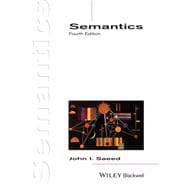- Covers all of the basic concepts and methods of the field of semantics, as well as some of the most important contemporary lines of research
- Features a series of new exercises, along with their solutions, that are arranged by level of difficulty
- Addresses componential theory, formal semantics, and cognitive semantics, the three main current theoretical approaches to semantics
- Includes revisions and updates that reflect the most recent theoretical developments









